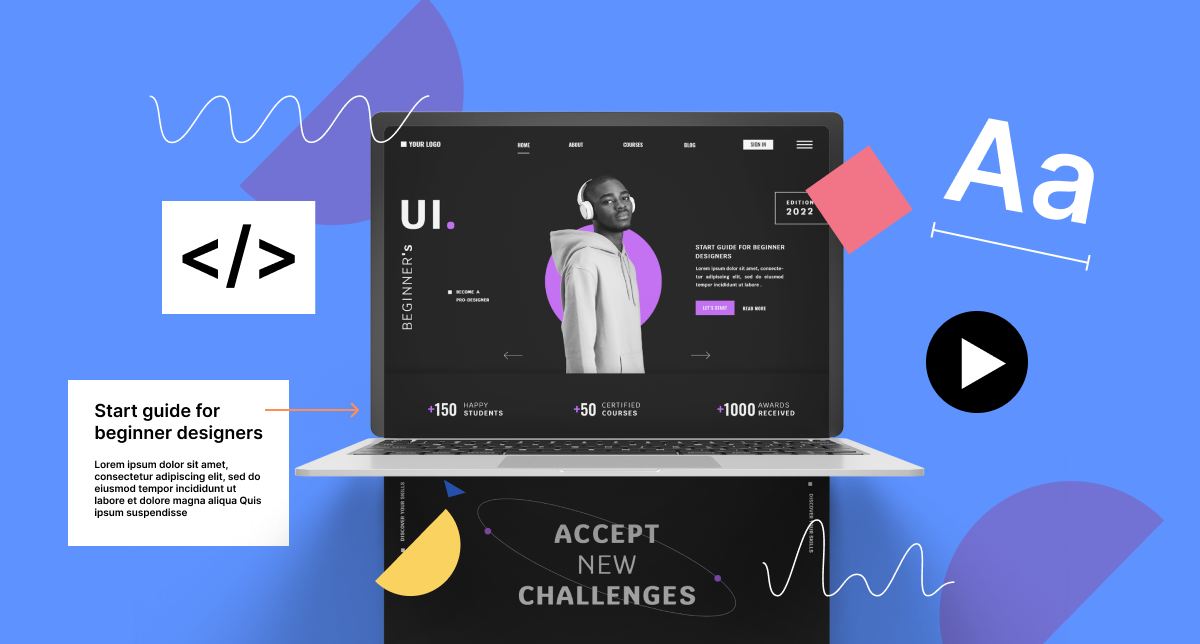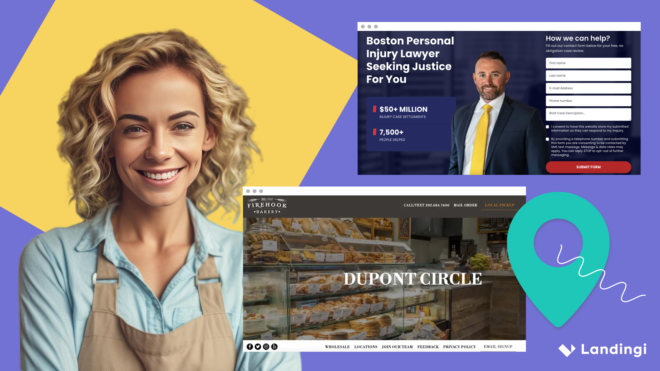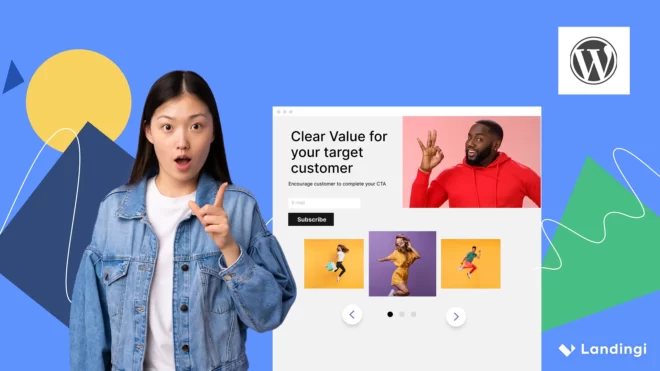A well-crafted website serves as a digital storefront, a beacon in the vast sea of the internet, drawing in visitors and converting them into customers. It’s your brand’s ambassador, working tirelessly around the clock to showcase your products, services, and values. But how to tackle it – if you haven’t done it before?
Understanding the Basics of Website Design
What is Website Design?
Website design melds aesthetics with functionality, creating a digital environment that’s not only visually appealing but also user-friendly. It’s about crafting an online space that reflects your brand’s identity while providing a seamless experience for visitors.
Elements of Website Design
Website design isn’t just about picking the right colors and fonts. It’s a complex process that involves several components. The layout dictates how different elements align on your pages, guiding the visitor’s eye and creating a visual hierarchy. Navigation should be intuitive, leading visitors through your site with ease. Typography, images, and other visual elements should align with your brand’s identity and enhance the user experience. This car loan company page design is a good example of website elements. The color, visuals, navigation is done so well that it completely aligns with their brand identity.
Make your sections smartable and let go of mundane manual tasks with Smart Sections! An easy way to manage bulk changes.
Planning Your Website
Defining Your Website’s Purpose
Before you dive into design, you need to clarify what you want your website to achieve. Are you selling products, providing information, showcasing a portfolio? Your website’s purpose will guide every design decision you make.

For example, it’s hard to get lost in Preset main messaging – as the CTA is clear as day.
Identifying Your Target Audience
Knowing who you’re designing for is just as crucial as knowing what you’re designing. Your target audience’s preferences, needs, and online behavior should influence your design choices, from color schemes to navigation menus.
Creating a Website Plan
A website plan is like a blueprint for your site. It outlines the site’s structure, features, and content, providing a clear roadmap for the design process.
Choosing a Domain Name
Your domain name is your website’s address on the internet. It should be easy to remember and reflect your brand’s name or the nature of your business.
Certifier made it clear what they are into – certificates. No mysterious data or name here, just the name of the brand that reflects the nature of the product.
Selecting a Web Hosting Service
Web hosting services store your website’s files and make them accessible to internet users. Your choice of host can affect your site’s performance and reliability, so it’s worth taking the time to compare options. It might be worth going for headless commerce as well.
Designing Your Website
Choosing a Website Platform
Website platforms provide the tools and templates you need to build your site. Some platforms cater to beginners, offering drag-and-drop design tools, while others cater to more experienced users, offering advanced customization options. Moreover, you can also take help from freelance web designers for designing the website.
Selecting a Website Template or Theme
Templates and themes provide a starting point for your design, defining the layout and aesthetic of your site. Choose one that aligns with your brand’s identity and the purpose of your site.
Customizing Your Website Design
Customization is where your website truly comes to life. This is where you tweak your chosen template or theme, adjusting colors, fonts, images, and other elements to create a unique digital space that embodies your brand.
For example, if you own an eCommerce store, personalizing your website design uniformly with your brand messaging becomes imperative. Traditional eCommerce platforms are template based and allow minimal customization. However, site owners can use an eCommerce frontend as a service solution to go headless and truly personalize their website.
Creating Quality Content
Content is the heart of your website. It’s what draws visitors in and keeps them coming back. Craft engaging, valuable content that resonates with your target audience and reflects your brand’s values.
You should also add social proof to your posts, like Usebouncer – email verification tool – has done.

Incorporating Multimedia Elements
Multimedia elements like images, videos, scheduling calendars, and interactive features can enhance the user experience, making your site more engaging and memorable. The visuals you use should depict your services very well that looks engaging and real.
For example, if your site is focused on dental procedures or you will use it for a dentist in turkey or any other country, then going for a sober professional look will be your safest bet.
Or, this landing page which is about weed abatement services, having pictures of how they work which makes the page engaging and visually appealing.
Optimizing Your Website for Search Engines (SEO)
Understanding SEO
SEO stands for Search Engine Optimization. It’s a set of strategies aimed at improving your website’s visibility in search engine results, driving more traffic to your site.
Keyword Research and Implementation
Keywords are the terms and phrases people use to search for content online. Identifying the right keywords for your website and incorporating them into your content can help improve your site’s SEO.
On-Page SEO Techniques
On-page SEO involves optimizing individual pages onyour website to rank higher in search engine results. This includes using relevant keywords in your content, optimizing meta descriptions, and creating SEO-friendly URLs.
For example, take a look at this truck parts page of American Trucks. They have properly optmized this page for SEO with proper URL structure, title, meta description that helps them rank for multiple terms related to their keyword and bring targeted traffic.

Off-Page SEO Techniques
Off-page SEO refers to actions taken outside of your website to improve its search engine rankings. This includes strategies like link building, social media marketing, and influencer outreach.
Monitoring SEO Performance
Tracking your SEO performance allows you to see what’s working and what’s not, so you can adjust your strategies as needed. Tools like Google Analytics can provide valuable insights into your website’s traffic, user behavior, and more.
Get 111 Landing Page Examples—The Ultimate Guide for FREE
Ensuring Website Usability
Creating a User-Friendly Interface
A user-friendly interface is intuitive and easy to navigate, making it simple for visitors to find what they’re looking for. It’s about creating a seamless experience that keeps users on your site and encourages them to come back.

Luigi’s Box website is really intuitive to scroll through, no matter the device or browser.
Mobile Responsiveness
With more people browsing the web on mobile devices, it’s crucial for your website to function well on smaller screens. A mobile-responsive design adjusts to fit the screen size, providing a consistent user experience across devices.
Website Loading Speed Optimization
Nobody likes a slow website. A fast-loading site improves the user experience, reduces bounce rates, and can even boost your SEO. Techniques for speed optimization include optimizing images, minimizing CSS and JavaScript, and using a reliable web host.
Maintaining and Updating Your Website
Regular Website Maintenance
Just like a car, a website needs regular maintenance to keep it running smoothly. This includes updating your platform and plugins, checking for broken links, and monitoring website performance.
Updating Content
Keeping your content fresh and up-to-date is crucial for keeping visitors engaged and improving SEO. Regularly add new blog posts, update product information, and refresh your homepage to keep things interesting.
For example, Smartsupp is experimenting with “join the waitlist” buttons on their conversational AI chatbot product pages:

Or AirOps on their SQL query optimization page, decided to test some pop-ups.

Regularly Testing Website Performance
Regular testing can help you spot issues with your website’s performance before they affect your users. Use tools like Google PageSpeed Insights or heatmaps from LiveSession to check your site’s speed, and regularly test your site’s functionality to catch any bugs or errors.
Conclusion
Designing a website is a complex process, but with careful planning, creative design, and ongoing maintenance, you can create a stunning online presence that truly reflects your brand.
All the tips provided in this guide remain valid for landing pages – a special type of website aimed at encouraging users to undertake desired actions and, in that way, increasing a conversion rate. With Landingi’s Free Plan you can build up and customize such a page much faster, without coding skills, and – last but not least – at zero cost!
So, roll up your sleeves and dive in – the digital world awaits!








